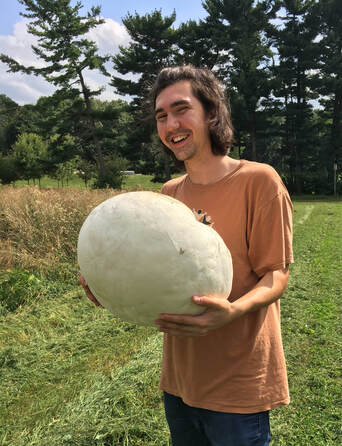
Alden Dirks is from Coatesville, Pennsylvania. He is currently doing research with Dr. Tim James in Ann Arbor, Michigan.
Tell us about your project!
Gyromitrin is an acute toxin and potent carcinogen that is found in some mushrooms, particularly false morel mushrooms (Gyromitra spp.). The product of gyromitrin metabolism, monomethylhydrazine, is infamous for also being a component of rocket fuel, which is as bad for you as it sounds like it would be. You’d think this would be a deterrent to the consumption of false morels. However, in Finland, the highly poisonous Gyromitra esculenta is widely harvested and consumed as a delicacy after first being prepared with a laborious parboiling and washing procedure to rid it of the majority of its gyromitrin. In Michigan there is also a culture of consuming certain false morel species, but these appear to be less toxic than the European species. But are they really? Despite its importance as a mycotoxin, we still don’t know which species produce gyromitrin or how much of it. False morels belong to a taxonomic family sister to that of the true morels (Morchella spp.). True morels should always be cooked thoroughly, in part because they are poisonous to many people when eaten raw, and these symptoms are strikingly similar to those caused by gyromitrin (although less severe). Our aim is to first determine which morel species (both true and false) contain gyromitrin, then find the genes responsible for its synthesis, and finally elucidate its evolutionary origin and history of horizontal gene transfer, if any. Along the way, we hope to formulate a set of best foraging practices for mushroom hunters in Michigan so that people can avoid gyromitrin exposure.
Awards you’d like to brag about?
At the end of my senior year at Swarthmore College, the Biology department awarded me the “Leo M. Leva Memorial Prize”, which recognizes undergraduates whose work shows “exceptional promise for future societal impact”. I strive to live up to this recognition!
What are your career goals/plans for after you’re done your current position?
I feel like infinity lies between me and the end of my current position, but at the end of the universe I might teach mycology and conduct research on fungal taxonomy and biodiversity at a small liberal arts or community college; or have a restorative agroforestry operation where I cultivate truffles, grow mushrooms, and raise sheep or goats; or maybe open a restaurant and a fungus-focused storefront.
What is your favorite fungus and why?
One of my favorites is Ganoderma applanatum, the artist’s conk – but not because you can draw on it. Rather, this mushroom is host to forked fungus beetles (Bolitotherus cornutus), which can live on the same shelf for about a decade and have a lifespan of up to 20 years (or so I’ve heard). I once had a pet artist’s conk with pet forked fungus beetles. Unfortunately, there are no blogs or help pages on taking care of forked fungus beetles. Needless to say, they didn’t live up to their long lifespan. But I’m confident next time things will go better and we will grow old together.
What is your favorite fact/thing about fungi?
The longevity and extent of the humongous fungus, the oldest and largest organism on earth, never ceases to amaze me.
Who is your mycology role model?
Barbara Mosse and Charles McIlvaine
Any great stories from field work (funny/interesting/something that stuck out to you)?
I collected a hearty bunch of jelly fungus to eat. Of course, mushrooms are best fried, so that’s what I did to this mushroom. I was soon screaming and running out the kitchen dodging hot bits of oily jelly fungus as the chopped up mushroom began exploding out of the pan! Pro tip: don’t fry jelly fungus.
What do you like to do in your free time? What are your hobbies?
I love to dance salsa and bachata!
Anything else you’d like to share?
I have the lifelong goal of eating 1001 species of mushroom (a one-up on Charles McIlvaine). You can read about my discoveries and eats at my website, aldendirks.com. I also have a soft spot for crust fungi, which are ecologically important as saprotrophs and ectomycorrhizae, but are poorly studied. As a side project, I am developing a website called crustfungi.com that I hope to build into the MushroomExpert of crusts.


Leave a Reply